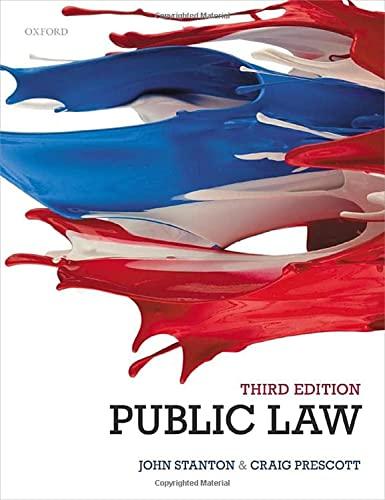Question
Fremont v. Dooley Arthur Dooley, a tenant in a large apartment building, had several grievances with the building's manager, Otis Fremont. Dooley designed a one-page
Fremont v. Dooley
Arthur Dooley, a tenant in a large apartment building, had several grievances with the building's manager, Otis Fremont. Dooley designed a one-page flier in which he asserted, "Fremont has a long record of criminal convictions as a landlord." Fremont had received three notices of violation from the local housing commission in the past two years for inadequate lighting and locks. The commission had then threatened to seek a court order requiring correction of the violations, but dropped the matter when Fremont made the necessary repairs. Fremont has no criminal record.
Dooley made 200 copies of the flier at his print shop for distribution to other tenants in the building. On his way back from the print shop, Dooley met Fremont by chance and, after a lengthy conversation, they settled their differences. The fliers were not mentioned. Although Dooley intended to destroy the fliers when he returned to his apartment, he was struck by a teenager riding a skateboard and the fliers were scattered by the wind. Many of the fliers were read by other persons, and Fremont filed suit for libel.
There are three relevant cases. All are from the highest appellate court of the State.
White v. Ball (1966)
Ball appeals from a libel judgment awarded to White and two other employees of the R&T Construction Company. Ball had hired the company to remodel his home. The judgment was based on a letter written by Ball to the company president shortly after the work was completed, in which Ball accused the employees of stealing a valuable watch.
The first issue on appeal is whether the letter was intentionally published. As a general matter, libel consists of the intentional publication of false statements about a person that humiliate the person or subject him to the loss of social prestige. All that is necessary for publication to occur is the delivery of the defamatory matter in written or other permanent form to any person other than the one libeled. It is receipt by a third person that makes the statements so damaging. Because the president of the company, a third person, received and read the letter, the trial court was correct in finding that there was intent to publish.
The second issue is whether the letter was false. On this issue, the trial court erred. A statement is false if the gist. the sting, of the matter is false. Minor inaccuracies in the statement are not sufficient to show that it is false. In this case, the accusation against the employees was, in a technical sense, false. None of the employees took the watch. But the watch was taken by a male friend of one of the employees when he picked her up at the end of the work day. Because of the relationship between the employee and the thief, we believe that the letter was substantially accurate.
Simmons v. Deluxe Plaza Hotel (1968)
The manager of defendant hotel wrote Simmons a letter falsely accusing Simmons of staying in the hotel, failing to pay for the room, and taking several articles from the room. The manager was mistaken as to the culprit's identity, so the letter was false. The letter was addressed to Simmons personally and sent by certified mail.
Simmons's wife signed for the letter at his residence and read it. The question on appeal is whether the trial court correctly ruled that letter was not intentionally published. The evidence shows the manager considered it possible that some third person might receive the letter, though he did not know Simmons was married. This falls far short of a showing that he was reasonably chargeable with appreciation or knowledge of the likelihood that the letter would be opened and read by another. A mere conceivable possibility or chance of such eventuality is, not sufficient to demonstrate intent. Affirmed.
Willow v. Orr (1991)
This case arises from a battle between the parties for custody of their four-year-old son, Matthew. Mr. Willow took Matthew from Ms. Orr's home without her consent or knowledge and traveled with him to another state. Ms. Orr looked for them for six weeks and, after she located them, obtained a court order compelling Matthew's return. Mr. Willow then told Ms. Orr, as part of their divorce proceeding, that he might take Matthew again. Thereafter, Ms. Orr wrote a letter to fifteen of her neighbors. The letter said, in part, "Help! Jason Willow kidnapped my child and said he would do it again." Mr. Willow sued Ms. Orr for libel. The trial court granted Ms. Orr's motion for summary judgment.
On appeal, Mr. Willow claims that the letter is false because he did not kidnap the child in the legal sense of that term. Because Mr. Willow's act did not violate any judicial custody order,he did not kidnap Matthew under the state statute. But technical errors in legal terminologyand reports of matters involving violations of the law are immaterial if the defamatory charge is true in substance. Because of the nontechnical meaning that "kidnap" has acquired in the child custody context, we hold that Ms. Orr's letter is substantially true. Affirmed.
Which is the strongest for your side? State the law and elements and apply them to the facts of your case. For example, inXXXXXX, the law is _________________. The first element is __________ and applies to our case because ___________________, etc.)
Step by Step Solution
There are 3 Steps involved in it
Step: 1

Get Instant Access to Expert-Tailored Solutions
See step-by-step solutions with expert insights and AI powered tools for academic success
Step: 2

Step: 3

Ace Your Homework with AI
Get the answers you need in no time with our AI-driven, step-by-step assistance
Get Started


